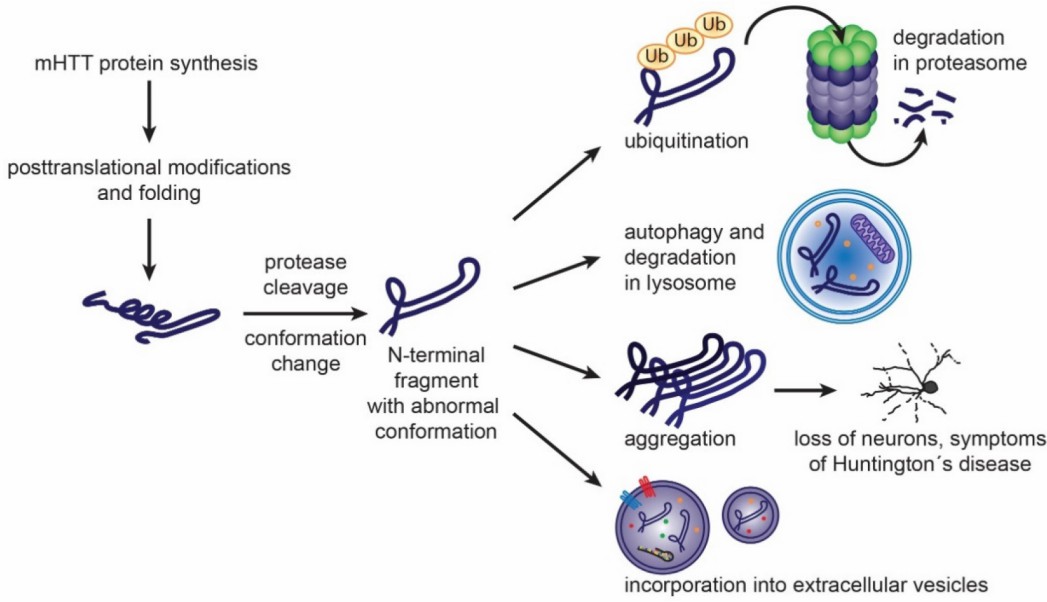Huntington's Disease Exosome Research Solution
Online InquirySimilar to Parkinson's disease (PD) and Alzheimer's disease(AD), Huntington's disease (HD) is another devastating neurodegenerative disease. As a chronic, slowly progressive genetic disorder caused by a single gene mutation, this disease can lead to confusion and bedriddenness following the onset of symptoms, causing a tremendous burden on patients and their families. Currently, there is no cure for HD, in large part because therapeutic compounds can not cross the blood-brain barrier (BBB). Exosomes are nanoscale extracellular vesicles secreted by almost all cell types, rich in nucleic acids, proteins and other biologically active substances, and involved in the pathogenesis of many diseases. Moreover, such vesicles can penetrate the BBB and are highly stable in peripheral circulation. This suggests a potential role for exosomes as biomarkers and carriers of drugs and other therapeutic molecules for the treatment of HD and other neurological diseases.
 Fig. 1 Formation of mHTT toxic species and cellular mechanisms to handle them. (Ananbeh, Hanadi, Petr Vodicka, and Helena Kupcova Skalnikova. 2021)
Fig. 1 Formation of mHTT toxic species and cellular mechanisms to handle them. (Ananbeh, Hanadi, Petr Vodicka, and Helena Kupcova Skalnikova. 2021)
Exosomes and occurrence of HD
HD is a neurodegenerative disease as well as an autosomal dominant hereditary disease affecting motor function, caused by mutations in the huntingtin gene (IT15). The pathogenic gene encodes a large soluble protein (350 kDa) consisting of 3144 amino acids, namely mutant Huntingtin (mHtt). mHtt is characterized by the presence of a polyglutamine (poly Q) region, a proline-rich region (PRR), and HEAT repeats that are important for protein interactions, as well as caspase and calpain cleavage sites in higher vertebrates. The main pathological change observed in HD is the presence of mHtt-forming inclusions and aggregates in the neurons of the central nervous system. Previous studies have demonstrated that exosomes have the potential to promote HD development by transporting the repeated RNA of a toxically amplified trinucleotide from one cell to another. Therefore, exosomes can be utilized as a biomarker for HD diagnosis and as a therapeutic tool for HD treatment.
HD exosome research solution at Creative Proteomics
Exosomes may serve as a potential source of novel, noninvasive biomarker and a possible carrier of novel therapeutic approaches for HD. However, the use of exosomes as biomarkers and carriers in HD is still in its early stages and more studies are needed in this area. Creative Proteomics is a leading service provider in exosome research and analysis. Based on years of experience in exosome research, we are able to help researchers and professionals to explore the role and application of exosomes in HD. Specifically, we offer the following services, but are not limited to them.
| Exosome analysis services | |
|---|---|
| Exosome isolation and purification | Sucrose gradient centrifugation |
| Polymer-based exosome enrichment method | |
| Immunomagnetic bead method | |
| Size exclusion chromatography method | |
| Exosome identification | Nanoparticle tracking analysis (NTA) |
| Electron microscopy analysis | |
| Western blot | |
| Exosome marker assay | Isolation and enrichment of exosomal CD9, CD63, CD81, TSG101, HSP70 proteins |
| Exosome surface protein identification and quantitative analysis | |
| Exosome engineering | Exosome labeling and tracking |
| Cargo loading | |
| Engineered exosome production | |
| Cargo loading assessment | |
| Exosomes labeling and tracking | Exosome fluorescent labeling |
| Fluorescence exosome purification | |
| Fluorescent exosome concentration labeling | |
| Exosome multiomics analysis | Exosome proteomics analysis: Exosome protein profile identification Exosome protein composition analysis Exosome protein expression level analysis Exosome protein differential expression analysis |
| Exosome metabolomics analysis: Exosome differential metabolite screening Qualitative and quantitative analysis of target metabolites/metabolic pathways | |
| Exosome lipidomics analysis: Exosome lipid composition and level analysis Differential expression analysis of exosomal lipid molecules Qualitative and quantitative analysis of targeted lipid molecules | |
| Exosomal biogenesis and identification | Our capabilities will provide strong support for the study of exosome biogenesis and its identification. |
| Exosomal cargo and loading mechanism | Our services can greatly help the study of exosomal cargo and loading mechanism, facilitating the diagnostic and therapeutic applications of exosomes. |
| Exosome function research | In vitro analysis of the function of exosomes In vivo analysis of the function of exosomes |
If you don't find what you're looking for, contact us and someone from our team will get back to you shortly.
References
- Ananbeh, Hanadi, Petr Vodicka, and Helena Kupcova Skalnikova. "Emerging roles of exosomes in Huntington's disease." International journal of molecular sciences 22.8 (2021): 4085.
- Yuan, Qian, et al. "Extracellular vesicles in neurodegenerative diseases: Insights and new perspectives." Genes & Diseases 8.2 (2021): 124-132.
* For Research Use Only. Not for use in diagnostic procedures.



